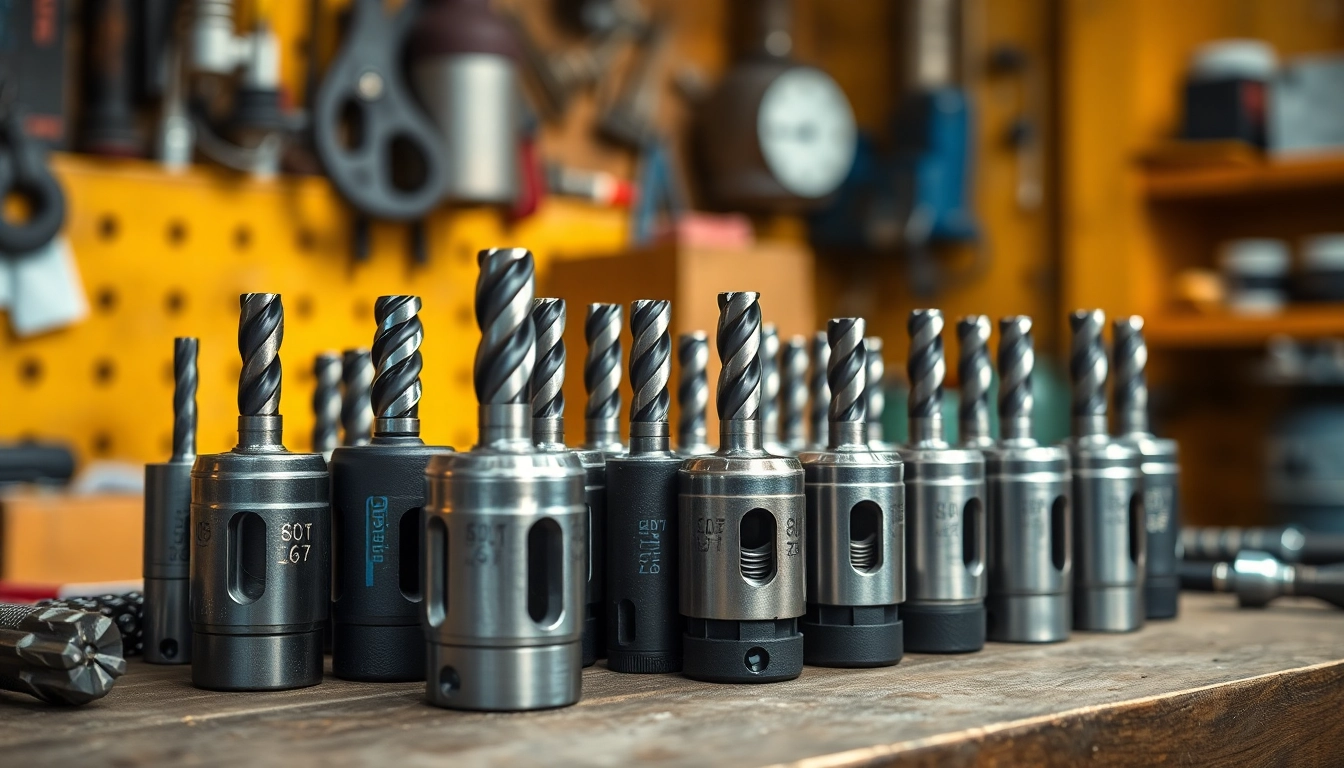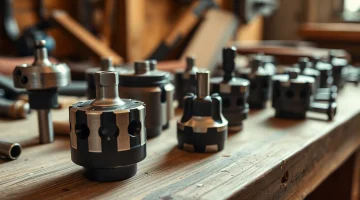
Essential Guide to Drill Chucks: Types, Functions, and Buying Tips
Understanding Drill Chucks
What is a Drill Chuck?
A drill chuck is a key component in the mechanics of drilling tools, serving as the device that holds the drill bit in place during operation. The significance of a drill chuck lies in its ability to grip the drill bit securely while allowing for seamless rotation, thereby ensuring precision and efficiency in drilling tasks. Drill chucks come in various designs and sizes, catering to different types of drilling machines, and their functionality can directly impact the performance and accuracy of drilling operations. Whether for casual DIY projects or professional applications, understanding drill chucks is essential for achieving the desired results.
For those looking to explore drill chuck options, it is essential to comprehend the fundamental principles that guide their operation.
How Drill Chucks Function
Drill chucks operate by utilizing mechanical systems that grip the shank of the drill bit, ensuring a secure hold during drilling. The mechanism typically includes jaws that expand or contract in a controlled manner. There are two primary types of drill chucks: keyed and keyless. In a keyed chuck, a specialized key is used to tighten or loosen the grips on the drill bit, whereas a keyless chuck allows user to adjust the chuck simply by hand. This fundamental difference affects the speed and convenience of changing bits.
Inside the chuck, the jaws function by either moving outward or inward, enabling the chuck to securely grasp different shank sizes. As a drill spins, the grip of the chuck must be firm enough to prevent slipping but not so tight as to risk damaging the bit. This balance is crucial for maintaining accuracy and prolonging the life of both the chuck and the drill bit.
Importance of Quality in Drill Chucks
The quality of a drill chuck is paramount, as it directly affects the tool’s performance. High-quality chucks ensure better alignment, improved concentricity, and minimal wobbling during use. This quality is especially vital in professional settings where precision is critical. Investing in high-quality drill chucks can improve tool life, accuracy, and overall project outcomes.
Additionally, well-manufactured drill chucks are often resistant to wear and tear, making them more durable over time. They provide a better grip and allow users to work with a wider range of drill bits, enhancing versatility on the job. In conclusion, the benefits of investing in a good drill chuck extend beyond performance alone; they positively impact the longevity of your machinery and the quality of your work.
Types of Drill Chucks
Keyed vs. Keyless Drill Chucks
The debate between keyed and keyless drill chucks often boils down to user preference and specific project requirements. Keyed chucks, which require a key for adjustment, are favored for their superior grip. This makes them ideal for applications that demand high torque, as there’s less chance of slippage. However, changing bits requires an extra step, which can be time-consuming, particularly in a fast-paced environment.
Keyless chucks, on the other hand, offer convenience. They allow for quick adjustments, making them popular among those who frequently change drill bits or operate in diverse manufacturing environments. However, depending on the quality, they may not grip as securely as keyed options, particularly during heavy-duty use.
Ultimately, the choice depends on the user’s needs: flexibility and speed or robustness and grip.
CNC and Precision Drill Chucks
CNC (Computer Numerical Control) and precision drill chucks are designed for operations requiring extreme accuracy. These chucks are particularly valuable in industrial applications where precise hole placement is crucial. Precision drill chucks have superior concentricity compared to standard chucks, resulting in less runout, which translates to more accurate drilling.
Moreover, CNC chucks can support advanced manufacturing techniques that demand exact specifications, reducing waste and defects. Implementing high-quality CNC chucks can lead to significant improvements in efficiency and product quality, making them worth the investment for serious manufacturers.
Hybrid Options: Pros and Cons
Hybrid drill chucks combine features of both keyed and keyless designs, offering a balance between security and convenience. These chucks often provide the best of both worlds, allowing users to switch quickly while still delivering strong grip strength. However, the complexity of their design can sometimes lead to mechanical issues or higher costs compared to standard options.
When considering hybrid drill chucks, users should weigh their specific needs against the potential trade-offs. For light- to moderate-duty applications, a hybrid model may serve well, but for heavy industrial use, users might prefer opting directly for key or keyless systems.
Choosing the Right Drill Chuck for Your Needs
Factors to Consider When Buying
When selecting a drill chuck, several important factors must be taken into account:
- Compatibility: Ensure that the chuck is compatible with your drill model, including the size and type of spindle. Most drills will accommodate either a 3/8” or a 1/2” chuck.
- Bit Size and Range: Consider the size of the bits you plan to use. Most chucks have specific size limits, and this must match the scope of your work.
- Grip Style: Decide between keyed, keyless, or hybrid varieties based on personal preference for ease of use versus the need for a secure grip.
- Material: High-carbon steel or reinforced materials offer better durability and performance. Make sure to check for build quality.
- Special Features: Some chucks come with added features such as self-tightening mechanisms or built-in torque adjustment, which can enhance usability.
Popular Brands and Their Offerings
Several reputable brands stand out in the drill chuck market:
- Jacobs: Known for producing reliable keyed chucks, Jacobs offers options known for precision and durability.
- Röhm: This brand emphasizes high-quality construction and precision, making it a favorite among professionals.
- Albrecht: Renowned for their high precision chucks, Albrecht comes with a premium price tag but is well-regarded for accuracy.
- Bosch: Offers a variety of keyless chucks tailored to both home improvements and professional applications.
- DEWALT: A trusted name in power tools, DEWALT also produces versatile chucks that fit a wide range of their drills.
Common Sizes and Compatibility
Drill chucks come in several sizes, commonly 1/2”, 3/8”, or 1/4”. Understanding compatibility with your specific drill is crucial for effective operation. The size of the chuck has implications not only for the size of the bits that can be used but also for the torque that can be applied during drilling. For instance, a 1/2” chuck is typically found in more heavy-duty drills that can accommodate larger bits, while 3/8” chucks are more common in lighter tools meant for general use.
Installation and Maintenance of Drill Chucks
Steps for Proper Installation
Installing a drill chuck correctly is vital for optimal performance. Here’s a step-by-step guide:
- Identify the Compatible Chuck Size: Always ensure that the drill chuck matches the spindle size of your drill.
- Remove the Old Chuck: If replacing an old chuck, use the appropriate tool to release it from the spindle. For keyed chucks, this typically involves unlocking it to release the drill bit.
- Attach the New Chuck: Align the chuck to the spindle and screw it on tightly by hand. For some models, you may require a chuck key.
- Check Alignment and Tightness: Rotate the chuck by hand to ensure it is securely fitted and properly aligned.
Maintaining Your Drill Chuck for Longevity
To ensure the longevity of your drill chuck, regular maintenance is essential. Here are some practical maintenance tips:
- Clean After Use: Dust and debris can accumulate and interfere with performance. Wipe the chuck clean with a dry cloth after each use.
- Lubrication: Apply a small amount of machine oil to the chuck’s jaws as recommended by the manufacturer. This helps prevent rust and ensures smooth operation.
- Inspect Regularly: Frequently check for wear and tear, ensuring the grip remains secure and there’s no visible damage to the chuck.
Troubleshooting Common Issues
Even the best drill chucks can face problems. Here are common issues and their solutions:
- Slipping Chuck: If the drill bit slips during operation, the chuck may not be tightened properly. Ensure it is secure. If the problem persists, inspect for wear.
- Worn Jaws: Over time, the jaws can wear out, resulting in a weak grip. In such cases, consider replacing the chuck.
- Loose or Tight Chuck Mechanism: If the mechanism feels too tight or too loose, refer to the manufacturer’s instructions for adjustments.
Comparing Drill Chuck Performance
Evaluating Accuracy and Precision
When assessing drill chucks, accuracy and precision are paramount metrics. They dictate how well the chuck can hold bits in place during use, ultimately affecting the quality of the finished work. To evaluate accuracy, consider the following:
- Runout Measurement: Runout refers to the deviation from perfect rotation. High-quality chucks typically ensure a runout of less than 0.01 inches, contributing to better finishing in drilled holes.
- Material Strength: Tougher materials reduce flexing during drilling, which leads to more accurate results.
Real-World Performance Reviews
Performance reviews from professionals and hobbyists alike can offer valuable insights into the real-world functioning of various drill chucks. Brands like Albrecht and Jacobs often receive high marks for their accuracy and grip strength, while budget brands may garner mixed reviews due to inconsistent quality.
User reviews typically highlight specific characteristics such as ease of use, stability under load, and the speed of bit changes as essential factors influencing satisfaction. A thorough read of user experiences can inform potential buyers about which drill chucks deliver as promised and which fall short.
Understanding Performance Metrics
When choosing a drill chuck, understanding performance metrics is crucial. Some key metrics to consider include:
- Grip Strength: This reflects the chuck’s ability to hold the drill bit securely and prevent slippage.
- Concentricity: This measures how true the chuck rotates relative to the drill’s axis—a critical factor for precision drilling.
- Durability Ratings: These provide insights into how well the chuck will perform under continuous use, which can be critical in industrial settings.



